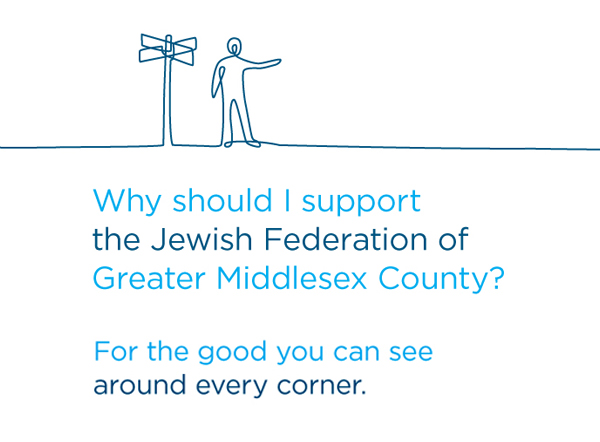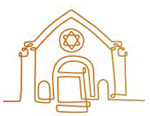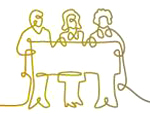CLIENT: Jewish Federation of Greater Middlesex County, NJ
How does your agency remain relevant to a new generation? It’s not easy, even for well-intentioned organizations. We worked with this Jewish Federation over 9 months to help them transition their brand to address the changing needs of their community. This case study describes the process we followed and lessons gleaned.
Part 1. Understanding Needs
Change Throughout the Federation System
The local federation that we worked with is not the first to address this issue. In fact, in order to create a more cohesive national brand, the United Jewish Communities, the umbrella organization for the federation system, had recently renamed themselves the Jewish Federations of North America to capitalize on the nomenclature that most federations were using. Also in the vein of creating more enthusiasm and consistency throughout the system, they unveiled a new logo and brand guidelines.
When we were hired in January 2010, ripples of change were already underway at the local federation. To start, the prior year, the local federation had commissioned a Demographic Study which found that, among other things, that they had the oldest Jewish community outside Florida, had one of the lowest number of donors giving more than $1,000, and was among the lowest per capita giving for 43 similar-sized federations. Clearly something needed to be done.
Seeds of Change
The local federation formed a strategic planning committee to explore how they could adapt. This committee resulted in five task forces to address specific areas including funding, marketing, outreach and engagement, Jewish education, and senior services. Three of these task forces had already developed recommendations for their specific areas before we arrived on the scene. As you can see, the federation’s approach of soliciting input from the community through committees was well entrenched and served as the driving force for their process.
When we were called in, our mandate was to create new marketing messages and materials that would help them increase their overall funding. Upon their request, we convened a Marketing Committee comprised largely of lay people who had been involved in the federation, but also some key staff.
Determining Community Needs
To determine the needs of the community, we conducted a Community Opinion Survey which asked about people’s beliefs and values, giving habits, and awareness of the federation’s programs. The online survey, promoted largely through email to their list of 6,500 people, was completed by nearly 600 people, largely federation supporters.
The findings were startling. Even long-time donors (who had been giving for 6 to 15 years, or 15 years or more), were unaware of how they had first heard of the federation, or were able to assess the value of the federation’s programs. Clearly, the federation had not done a good job in communicating the impact of their programs, even to people who had given on a regular basis. In light of the fact that the number of donors was decreasing steadily every year, this was a problem.
We uncovered other useful information to work with. The top values shared by the respondents included: ensuring Jewish continuity for the Jewish people, raising children with Jewish values, creating a Jewish home, doing good deeds, and being a part of a community — all things the federation could speak to.
Another finding showed that people valued the programs in the local community more than helping Jews abroad or in Israel. While this has been a core message of the federation system, their allocation to the American Jewish Joint Distribution Committee (JDC) and the Jewish Agency for Israel (JAFI) had shifted from 50% to 30% over the past several years. This message had not gotten out. Clearly, we needed to explain the value that the federation was having in the local community.
Defining the Audience
Armed with this knowledge, we knew we needed to get the message out. But first we needed to determine who our audience was. While educating current donors was important, the real goal was reaching out to potential new donors to widen to federation’s base of support. Given the federation’s limited budget, our message would need to have cross-over appeal for both audiences.
Part 2. Defining the Message
Defining Community
Since the federation’s main role is in building Jewish community, I thought a good way to kick off the process would be to introduce this definition of the word community as people who have shared experiences, values, and interests. The shared experiences relate to our common history as Jewish people, as well as the more recent developments of our local community. Shared values relate to our common beliefs in the ten commandments, tzedakah (charity), tikkun olam (repairing the world) and hesed (kindness). And perhaps the most relevant of the three, shared interests, refers to the concerns and dreams that we have for a secure job and affordable housing, being able to educate our children, and having social support structures for the less fortunate. To cut across denominational lines and create a connection to people’s own interests, the federation’s message would need to live at the intersection of these factors.
Defining the Federation’s Role
So what is the federation all about? Ask 10 people, and you’ll get ten different answers. That’s what we did. Our interviews with each of the staff members revealed narrow and specialized perceptions of the agency. From that, we assessed that the Federation played many important roles in the community including:
- Connector of diverse groups
- Identifier of unmet needs
- Standard-bearer of Jewish continuity
- Supporter of community institutions
- Advocate for the Jewish community
- Resource locally and globally
- Steward of donations
- Safety Net for financial emergencies
- Go-to agency for Jewish projects
Creating Key Messages
Digesting the information up to this point, we determined that as key points the federation needed to convey how they addresses local needs, how they unite the community, how they are in a unique position to do things that other organizations cannot, and show the impact of donors’ contributions (in general, and specifically in the county).
As secondary points, we needed to present the federation as a leader in the community, show that it cuts across denominational lines, and creates a connection to people’s own interests and values.
Toward that end, we presented three overall themes that the federation could use to promote the agency:
- “The good can you see around every corner.”
- “Become a humanitarian of many.”
- “A voice for your values. A force for our future.”
We presented the pros and cons of each concept and while there was enthusiasm for concept 1, we ultimately directed the Marketing Committee toward the “A voice for your values. A force for our future.” We thought that this best connected people’s personal interests and desire to do good with the collective force of the federation.
We incorporated this into an ad and brochure which we presented at the next meeting. However, during that meeting, as well as in our own creative process of developing the marketing materials, we could not remember the tagline. While cognitively, it conveyed what we wanted to say, it lacked the sizzle expressed by “The good you can see around every corner.”

And so we rescinded our original recommendation and suggested using “The good you can see…” line instead. Agreeing that this was more memorable and accessible, the marketing committee voted to adopt this line instead. We subsequently developed an ad, brochure and presentation that uses the headline: “Why support the Jewish Federation? For the good you can see around every corner.” The visual is a thin line drawing that creates the shape of community institutions representing the various aspects of the federation’s work (house for Jewish home life, school for Jewish learning, social service building for social services, etc.). This approach clearly lays out to current and prospective donors the scope of the federation’s services and impact that the agency has in the community.
Part 3. Ushering in Change
Changing the Mission Statement
Simultaneously, we thought that we could use the process for developing this message to drive larger change in the organization. In a way it was putting the cart before the horse, but in this case, the cart had already left the station with the strategic planning committee the year before.
Nonetheless, the original mission statement had remained: The Jewish Federation is a nonprofit organization that raises funds for Jewish humanitarian needs. Based on the heritage of Jewish values, the Federation is committed to the quality survival, strength and vitality of the Jewish people, locally, nationally, and worldwide.
During previous discussions, the marketing committee explored the concept that in order to address the fact that Jews were leaving the county, one of the goals of the federation should be to attract more Jews to the area. This stance reflected the belief that the federation would not have a vibrant base to draw upon in the future if they did not address this issue directly now. The current mission statement did not address this issue at all. Was it time to touch this sacred cow?
To broach this subject without treading on the mission statement itself, I presented two different statements to the marketing committee to stimulate discussion about the federation’s larger role:
- The Federation is the only organization that brings Jews together to create a community and pool their resources to ensure that no Jew’s need is unmet.
- The Federation develops and funds innovative programs to make the county a desirable community for young Jewish families to settle.
The ensuing discussion led to the group’s realization that these concepts were necessary to adopt in some way (while taking issue with some aspects of the language, such as “pool their resources.” And so the group developed the following as a working mission statement: The Jewish Federation empowers Jews to combine their resources and put their values into action to make our Jewish community vibrant and attractive, as well as to provide for Jews in need locally and around the world.
This mission statement was discussed in subsequent meetings and with input from the executive staff, the mission statement was refined to:
The Jewish Federation of Greater Middlesex County brings together people, partners and resources to fulfill the most important needs and aspirations of our community.We care for the vulnerable locally and worldwide, forge strong connections with Israel, attract people to a more vibrant community, and inspire the next generation to embrace Jewish life.
This refined the mission statement was presented to the board’s Executive Committee in the context of a presentation about all the work that had been done in the previous year by the strategic planning committee, the findings of the demographic study, and the community opinion survey, as well as the message development work of the marketing committee. The board received the message well: change was necessary. Still, some board members pushed back at the shift in mission.
Implications for Change
The marketing committee’s recommendations did not come lightly. Understanding that the shift in language on the mission statement equals a shift in their mandate, meant that ultimately the Executive Committee would have to grapple with the implications for the organization. We identified five areas that might be impacted: Programs and Events, Allocations, Staffing and Operations, and Fundraising.
There have since been changes in staff and the agency is starting to explore how they can adapt their allocations process to new needs. Just as important, they are exploring how to better present their financials so that they are not showing a million dollar difference between their revenue and their allocations (the large difference caused by not counting their own programs in their allocations budget). As you can imagine, this requires some re-working of their operations and reporting.
Certainly, changing an organization created in another generation, led by board of people over fifty years old and resistant to change, is a struggle. Doing so while maintaining a community-led approach makes it that much more difficult — they have deployed yet another committee, an Implementation Committee, to see the work through. While they are in a good position to continue making positive changes, it will be interesting to see if they can catch up with the pace of change occurring in the world.
Related Stories
 Read “Lessons from Branding a Jewish Agency”
Read “Lessons from Branding a Jewish Agency”
 Howard Adam Levy, is Principal of Red Rooster Group, a New York based graphic design firm that creates effective brands, websites and marketing campaigns for nonprofits to increase their visibility, fundraising and communications effectiveness. Contact us at info@redroostergroup.com.
Howard Adam Levy, is Principal of Red Rooster Group, a New York based graphic design firm that creates effective brands, websites and marketing campaigns for nonprofits to increase their visibility, fundraising and communications effectiveness. Contact us at info@redroostergroup.com.- See other nonprofit brand case studies.
- Contract Red Rooster Group for help with your nonprofit branding and marketing.





